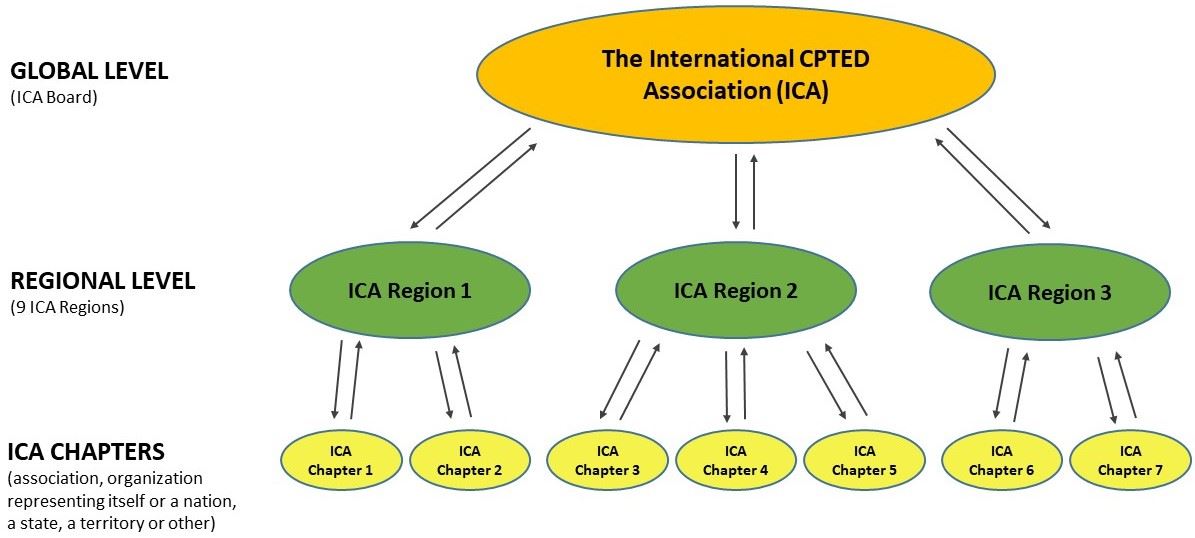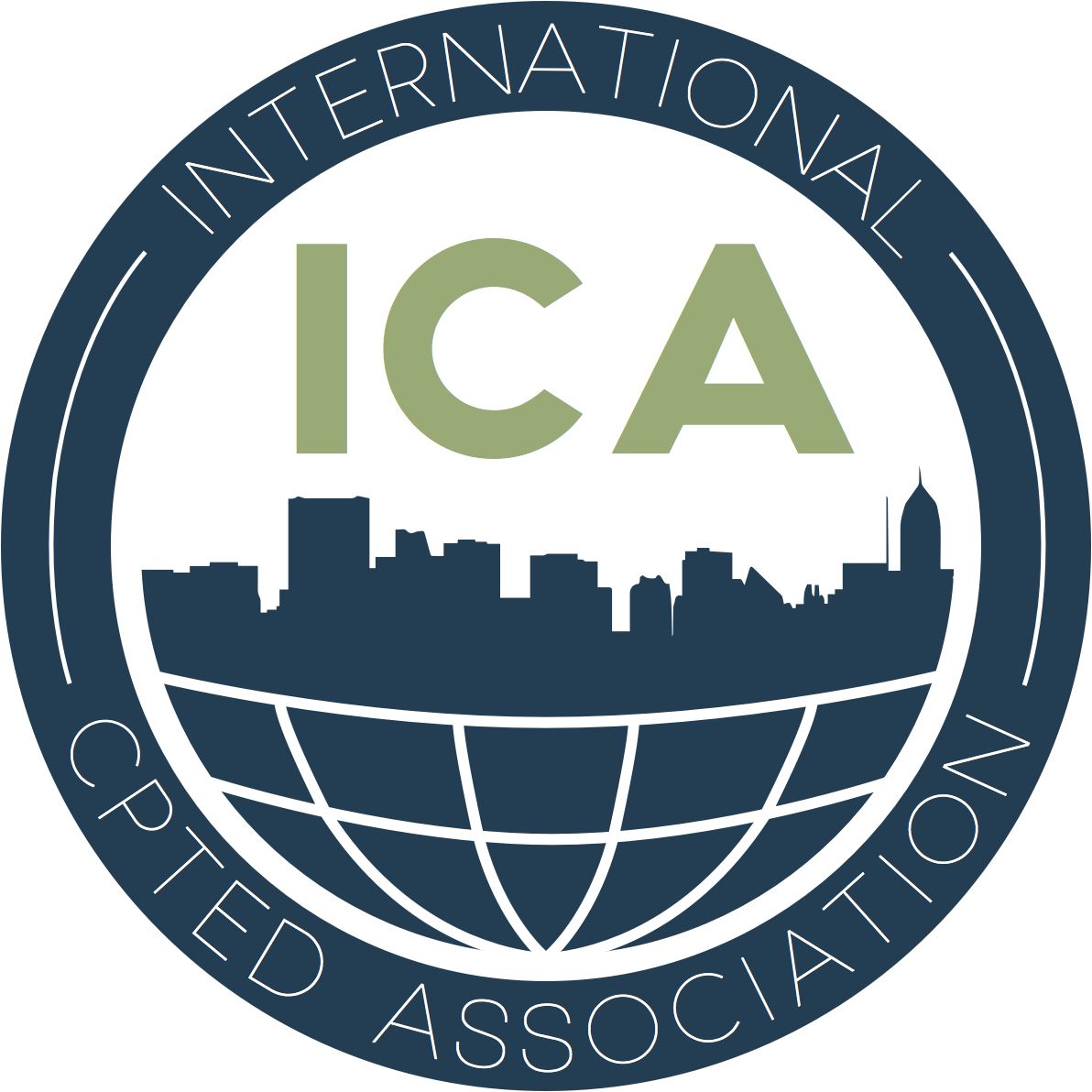ICA Umbrella Initiative & Organizational Structure
The ICA Umbrella Initiative was adopted by the ICA Board on 17 April 2020 to promote knowledge and application of CPTED through stronger collaboration between the ICA and various ICA organizations and groups (Chapters). This page provides an overview of the Umbrella Initiative and the ICA Organizational Structure. Contact us for more information: office@cpted.net. |
- Home
- Umbrella Initiative
The purpose of the ICA Umbrella Initiative is to promote CPTED as a viable crime prevention approach, to promote the knowledge of CPTED, and advance CPTED theory and practice through collaboration between 3 ICA organizational levels: Global (the ICA), Regional (ICA Regions), and ICA Chapters (associations, organizations representing nations, states, territories, various organizations...). We believe that a linked network of these three levels will foster exchange of knowledge, promote innovation, build CPTED community and overall, strengthen the field of CPTED. We consider diversity between the regions and nations a strength that will allow us to learn from each other and advance CPTED to improve safety, liveability and the quality of life for local communities. The diagram below provides a schematic demonstration of these interlinked level and bi-directional communication channels:
For more information and the role of each level please see our ICA Organizational Structure below. We invite associations, organizations and other entities with an interest in CPTED to apply to join us as an ICA Chapter. Please review the Application Process and Application + Strategic Plan Requirements. Contact us for more information if needed. |
The ICA Organizational Structure – ICA Organization Levels and Roles
ICA organizational structure on 1 September 2023 The ICA organizational structure distinguishes between 3 interlinked levels: 1. ICA – Global Level: the International CPTED Association (ICA) (https://cpted.net) 2. ICA Regions – Regional Level: ICA regions as defined on the ICA website (https://cpted.net/ICA-Regions)1 3. ICA Chapters: countries/sovereign states (as e.g. listed by the UN: https://www.un.org/en/member-states/), states, provinces or territories (as e.g. in Australia, Canada, USA), or any parts or combinations of any of those. Organizations or professional departments from within any of these geographic entities can also become chapters. The ICA distinguishes between two types of ICA chapters: ICA Chapters (MOU) and Affiliate Chapters (Agreement) 1 This structure reflects the current membership distribution. The ICA will revisit the membership and representation structure regularly as new members join the organization and regional membership continues to expand. *** 1. The International CPTED Association (ICA) – Global Level (ICA HQ)● Global umbrella for ICA Regions and ICA Chapters. ● The official ICA website is: https://cpted.net/. ● Supports CPTED and ICA developments and initiatives in collaboration with the ICA Regions and ICA Chapters. ● Supports ICA Regions and ICA Chapters in promoting and advancing CPTED. ● Promotes the development of CPTED and strategically coordinates ICA-related initiatives globally. ● Liaises and collaborates with global organizations such as the Worldbank, UN, etc. ● Manages the ICA’s individual CPTED certification (ICCP) and CPTED course accreditation (CAP) programs, and acts as an umbrella for any mutually agreed-upon certification and accreditation schemes managed by the ICA Chapters. ● Propagates, coordinates and organizes worldwide standardization of CPTED strategies and processes, and supports regional and national standardization. ● Develops and provides a repository of information for the global CPTED community (e.g. guidebooks, academic research, CPTED reference list, etc.). ● Organizes events such as biennial international conferences, webinars, and any other forthcoming initiatives, as well as contributes to regional events, if needed. 2. ICA Regions – Regional Level● Each ICA Region serves as an umbrella of networked ICA Chapters within that region. ● ICA Regions are outlined on the ICA website (http://cpted.net/ICA-Regions). ● Most ICA Regions have an appointed Regional Director who is an ICA Board member. This person supports the coordination of CPTED developments and collaborates closely with the ICA Chapters in the region, supports events and/or meetings in the region, networks with members and relevant organizations or institutes, shares regionally relevant information, and provides support with fundraising. ● Regional Directors regularly update the ICA Board with a summary of activities, achievements, challenges and other developments in the region. In collaboration with the ICA and ICA Chapters in the region they also develop a strategic plan for the region. They update that strategic plan every two (2) years for presentation to the ICA Board at the board meeting held at time of the international ICA conference. Regional Directors must attend the international ICA Conference, and any ICA Regional Conferences, in person. ● If the ICA Region has other members on the ICA Board in addition to the Regional Director, they must work together as a regional team. If the ICA Region has no Regional Director, other ICA Board members in the region should jointly assume the tasks of a Regional Director until that position has been filled. ● If in the interest of the Region, Regional Directors might coordinate and organize regional standardization of the contents and process of CPTED and support national standardization (see e.g. the European standardization of CPTED by CEN). ● Expectations of Regional Directors will be further specified in the ICA Regulations. 3. ICA ChaptersA. ICA Chapter (MOU)● An association or organization with a primary or extensive focus on CPTED. ● May represent and encompass countries/sovereign states; states, provinces or territories; or any parts or combinations of any of those. ● The Chapter has an official structure with the bylaws registered in one of the countries it is representing, and its own membership scheme. ● Requires a Memorandum of Understanding (MOU) with the ICA – renewed every three (3) years. With this agreement the ICA Chapter will become part of the “ICA Region” network. ● Before signing or renewing the MOU, the chapter representatives will prepare a strategic plan outlining the current state of CPTED in their chapter geographical area, challenges and opportunities, and intended actions for the next three (3) years (a template further outlining the requirements will be provided). The strategic plan will be updated every three (3) years; every (1) year the chapter representatives will also provide the ICA Board with a short written update on the progress of actions specified in the strategic plan and the chapter’s membership numbers. ● The chapter may administer CPTED certification in its own language (this includes ownership over the management of certification and registration payments). To be considered an “ICA recognized program”, that certification program needs to be initially reviewed and approved by the ICA Certification and Accreditation Committees and subsequently audited every 5 years. If the Certification Committee introduces significant changes to the program, the ICA chapter must also update its program within an agreed upon period. If the ICA chapter intends to make significant changes to its certification program, it must notify the ICA Certification Committee of this intention. The program administered by the ICA chapter must follow the same minimum competency unit requirements and renewal conditions (every 3 years). At least three (3) members of the Chapter who administer the program must be certified by the ICA (ICCP-Professional) and remain ICA members in good standing. ● The chapter will adhere to the protocol set out in the signed MOU regarding the promotion of the ICA and the use of the ICA logo on their website, social media, etc. ● At least one (1) member of the prospective ICA Chapter's leadership team will be an ICA member in good standing for at least one (1) year before being able to apply to become an ICA MOU Chapter. ● The members of the ICA MOU Chapter holding leadership positions (Chair/President, Treasurer, Secretary, and, if available, Vice-President and Executive Director; or another type of Executive Committee structure following national legal requirements of the country in which the chapter is registered - at least three (3) members in total) will be registered ICA members in good standing at time of applying to become an MOU Chapter and during the lifecourse of their ICA MOU Chapter status. Note: Members of the ICA Chapter do not automatically become members of the ICA. If a member of the chapter would like to be a registered member of the ICA, she/he needs to pay the membership fee, unless she/he is a member of the ICA Board. ● At least one member of the ICA Chapter’s leadership team will attend the International CPTED Conference held every 2 years, and a special workshop session at that conference intended specifically for ICA Chapters. If the Chapter representative is not able to attend in person, they will join the session using virtual meeting tools. B. Affiliate Chapter (Agreement)● An association or organization that may not focus primarily on CPTED, but may include CPTED in some of their activities (e.g. university departments, local governments, research institutes/groups, regional umbrella organizations for crime prevention, or Neighborhood Watch Associations). ● May or may not have a formal structure and/or membership. ● Requires a written agreement with the ICA – renewed every three (3) years. With this agreement the Affiliate Chapter will become part of the “ICA Region” network. ● Before signing or renewing the agreement, the chapter representatives will prepare a strategic plan outlining the current state of CPTED in their chapter area or organization, challenges and opportunities, and intended CPTED- related actions for the next three (3) years (a template further outlining the requirements will be provided). The strategic plan will be updated every three (3) years; every (1) year the chapter representatives will also provide a short written update on the progress of CPTED-related actions specified in the strategic plan. ● The chapter will adhere to the protocol set out in the signed agreement regarding the promotion of the ICA and the use of the ICA logo on their website, social media, etc. ● At least one (1) member of the prospective Affiliate Chapter's leadership team will be an ICA member in good standing for at least one (1) year before being eligible to apply to become an ICA Affiliate Chapter. ● At least three (3) members of the Affiliate Chapter's leadership team will be registered ICA members in good standing at time of applying to become an Affiliate Chapter and during the lifecourse of their Affiliate Chapter status. Note: Members of the Affiliate ICA Chapter do not automatically become members of the ICA. If a member of the Chapter would like to be a registered member of the ICA, she/he needs to pay the membership fee, unless she/he is a member of the ICA Board. ● At least one member of the Affiliate Chapter’s leadership team will attend the International CPTED Conference held every 2 years, and a special workshop session at that conference intended specifically for ICA Chapters. If the Chapter representative is not able to attend in person, they will join the session using virtual meeting tools. Adopted: 17 April 2020 Last revision: 10 June 2021 |
ICA Mission Statement
To create safer environments and improve the quality of life through the use of CPTED principles and strategies


